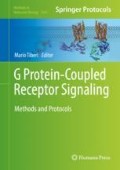Abstract
A variety of FRET-based biosensors are currently in use for real-time monitoring of dynamic changes of intracellular cAMP. Due to differences in sensor properties, unique features of the cell type under examination and diverse specifications of the imaging setups in different laboratories, data generated using these sensors may not be immediately comparable within the same study or across studies. To facilitate comparison, often FRET data are normalized and expressed as fractional change of the maximal FRET response at sensor saturation. However, this approach may lead to misinterpretation of the underlying cAMP change. In this chapter, we provide examples of the problems that may arise when using normalized FRET data and present a method based on the conversion of FRET ratio changes into actual cAMP concentrations that mitigates these issues.
Access this chapter
Tax calculation will be finalised at checkout
Purchases are for personal use only
References
Förster T (1948) Zwischenmolekulare energiewanderung und fluoreszenz. Ann Phys 437:55–57. https://doi.org/10.1002/andp.19484370105
Stryer L (1978) Fluorescence energy transfer as a spectroscopic ruler. Annu Rev Biochem 47:819–846. https://doi.org/10.1146/annurev.bi.47.070178.004131
Adams SR, Harootunian AT, Buechler YJ et al (1991) Fluorescence ratio imaging of cyclic AMP in single cells. Nature 349:694–697. https://doi.org/10.1038/349694a0
Zaccolo M, De Giorgi F, Cho CY et al (2000) A genetically encoded fluorescent indicator for cyclic AMP in living cells. Nat Cell Biol 2:25–29. https://doi.org/10.1038/71345
DiPilato LM, Cheng X, Zhang J (2004) Fluorescent indicators of cAMP and Epac activation reveal differential dynamics of cAMP signaling within discrete subcellular compartments. Proc Natl Acad Sci U S A 101(47):16513–16518. https://doi.org/10.1073/pnas.0405973101
Nikolaev VO, Bünemann M, Hein L et al (2004) Novel single chain cAMP sensors for receptor-induced signal propagation. J Biol Chem 279:37215–37218. https://doi.org/10.1074/jbc.C400302200
Klarenbeek J, Goedhart J, van Batenburg A et al (2015) Fourth-generation epac-based FRET sensors for cAMP feature exceptional brightness, photostability and dynamic range: characterization of dedicated sensors for FLIM, for ratiometry and with high affinity. PLoS One 10(4):e0122513. https://doi.org/10.1371/journal.pone.0122513
Di Benedetto G, Zoccarato A, Lissandron V et al (2008) Protein kinase A type I and type II define distinct intracellular signaling compartments. Circ Res 103(8):836–844. https://doi.org/10.1161/CIRKRESAHA.108.174813
Sprenger JU, Perera RK, Steinbrecher JH et al (2015) In vivo model with targeted cAMP biosensor reveals changes in receptor-microdomain communication in cardiac disease. Nat Commun 6:6965. https://doi.org/10.1038/ncomms7965
Surdo NC, Berrera M, Koschinski A et al (2017) FRET biosensor uncovers cAMP nano-domains at β-adrenergic targets that dictate precise tuning of cardiac contractility. Nat Commun 8:15031. https://doi.org/10.1038/ncomms15031
Nikolaev VO, Bünemann M, Schmitteckert E et al (2006) Cyclic AMP imaging in adult cardiac myocytes reveals far-reaching β1-adrenergic but locally confined β2-adrenergic receptor-mediated signaling. Circ Res 99:1084–1091. https://doi.org/10.1161/01.RES.0000250046.69918.d5
Herget S, Lohse MJ, Nikolaev VO (2008) Real-time monitoring of phosphodiesterase inhibition in intact cells. Cell Signal 20:1423–1431. https://doi.org/10.1016/j.cellsig.2008.03.011
Halls ML, Cooper DMF (2010) Sub-picomolar relaxin signalling by a pre-assembled RXFP1, AKAP79, AC2, β-arrestin 2, PDE4D3 complex. EMBO J 29:2772–2787. https://doi.org/10.1038/emboj.2010.168
Agarwal SR, Yang PC, Rice M et al (2014) Role of membrane microdomains in compartmentation of cAMP signaling. PLoS One 9(4):e95835. https://doi.org/10.1371/journal.pone.0095835
Boerner S, Schwede F, Schlipp A et al (2011) FRET measurements of intracellular cAMP concentrations and cAMP analog permeability in intact cells. Nat Protoc 6:427–438. https://doi.org/10.1038/nprot.2010.198
Koschinski A, Zaccolo M (2017) Activation of PKA in cell requires higher concentration of cAMP than in vitro: implications for compartmentalization of cAMP signalling. Sci Rep 7(1):14090. https://doi.org/10.1038/s41598-017-13021-y
Iancu RV, Ramamurthy G, Warrier S et al (2008) Cytoplasmic cAMP concentrations in intact cardiac myocytes. Am J Physiol Cell Physiol 295(2):C414–C422. https://doi.org/10.1152/ajpcell.00038.2008
Wachten S, Masada N, Ayling LJ et al (2010) Distinct pools of cAMP centre on different isoforms of adenylyl cyclase in pituitary-derived. GH3B6 Cells 123(Pt 1):95–106. https://doi.org/10.1242/jcs.058594
Koschinski A, Zaccolo M (2015) A novel approach combining real-time imaging and the patch-clamp technique to calibrate FRET-based reporters for cAMP in their cellular microenvironment. Methods Mol Biol 1294:25–40. https://doi.org/10.1007/978-1-4939-2537-7_3
Acknowledgments
This work was supported by the British Heart Foundation (PG/10/75/28537 and RG/17/6/32944) and the BHF Centre of Research Excellence, Oxford (RE/13/1/30181).
Author information
Authors and Affiliations
Corresponding author
Editor information
Editors and Affiliations
Rights and permissions
Copyright information
© 2019 Springer Science+Business Media, LLC, part of Springer Nature
About this protocol
Cite this protocol
Koschinski, A., Zaccolo, M. (2019). Quantification and Comparison of Signals Generated by Different FRET-Based cAMP Reporters. In: Tiberi, M. (eds) G Protein-Coupled Receptor Signaling. Methods in Molecular Biology, vol 1947. Humana Press, New York, NY. https://doi.org/10.1007/978-1-4939-9121-1_12
Download citation
DOI: https://doi.org/10.1007/978-1-4939-9121-1_12
Published:
Publisher Name: Humana Press, New York, NY
Print ISBN: 978-1-4939-9120-4
Online ISBN: 978-1-4939-9121-1
eBook Packages: Springer Protocols

